2017 Activity Report
March Activity Report
30 March 2018
Global Japan Office Coordinator
Michiko Imai
Today is the 30th of March which marks the end of the end of term examination period here at the University of Yangon, and from now on we will have a two month long break. The students have become sparse.
There are about 1000 books at the GJO which were gifted to the university by TUFS, and anyone from the University of Yangon can borrow them. Before the break began, three regulars visited the office. They are all third year students in the law department who often borrow manga, but this time they borrowed textbooks for the Japanese Language Proficiency Test.
It seems that these three students only studied Japanese at a volunteer class at a monastery, but they are all sitting N2 (the second highest level) this year. They are very good at speaking, and always say ‘excuse me’ when they enter and leave the office. They have very good manners, and I almost mistake them for polite Japanese students. The monasteries in Yangon hold free Japanese classes taught by volunteers. It seems that most of the teachers are Burmese volunteers, but there are a few places with Japanese volunteers. The composition of each class seems to depend on the monastery itself. Maybe these students are particularly good at learning languages, but whatever the case, it is amazing that these classes were able to produce students with such high Japanese proficiency and communication skills.
Unfortunately, the GJO currently only offers beginner-level Japanese classes, so there are no appropriate classes for them, and I can only offer them books. I hope the students learning through the GJO can become skilled at Japanese, and develop an appreciation for Japanese culture like these girls have.
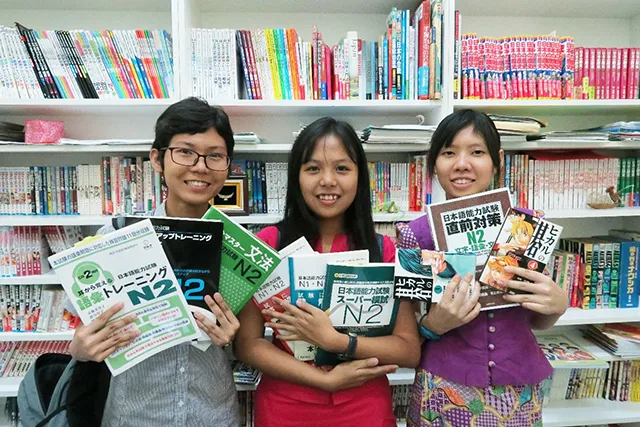
February Activity Report
5 March 2018
Global Japan Office Coordinator
Michiko Imai
The heat has returned in Myanmar. Every day the maximum temperature is recording around 35 degrees.
During this hot period, some refreshing guests visited the Yangon GJO. These guests were the four Kokushikan exchange students who studied at Yangon University on a language learning exchange last year and the year before. The day they participated in my class was the day the LEVEL 3 class was covering the ‘I am doing ~’ structure used when talking about your major, occupation and address. The visiting students practiced this structure with the Burmese students by asking them about their majors and where they live. Even though I didn’t tell them to do self-introductions, the Burmese students were very enthusiastic and introduced their names as well as their Japanese names. After having simple conversations, I had the students get up one by one and introduce themselves using the structures they had just practiced. It was amusing to see the Japanese students more nervous than the Burmese students. I am happy that my students have become able to speak Japanese without being so hesitant.
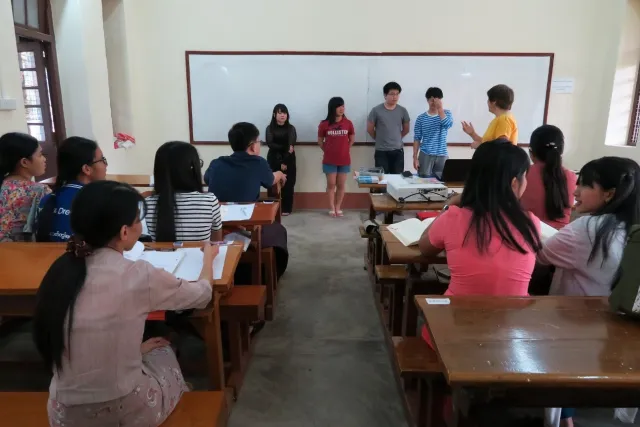
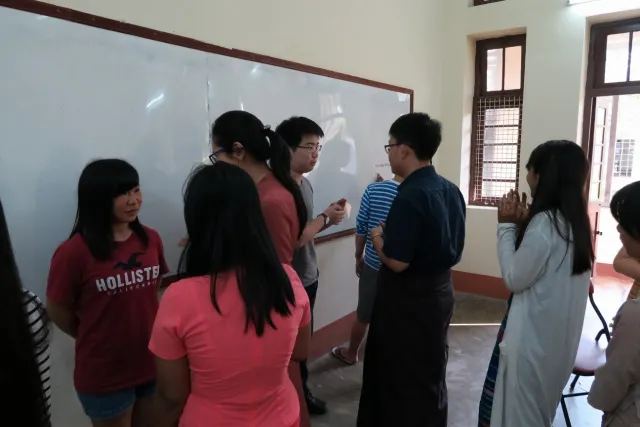
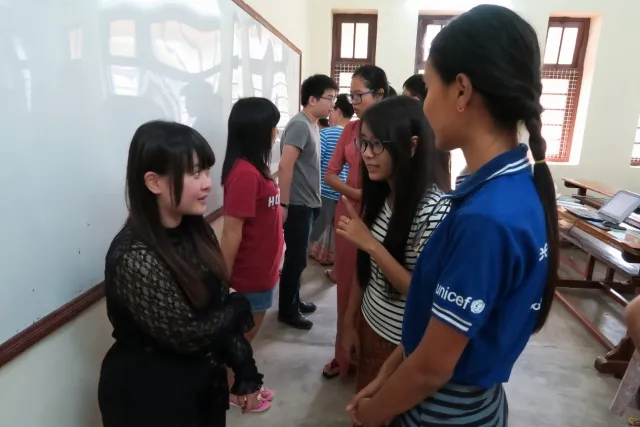
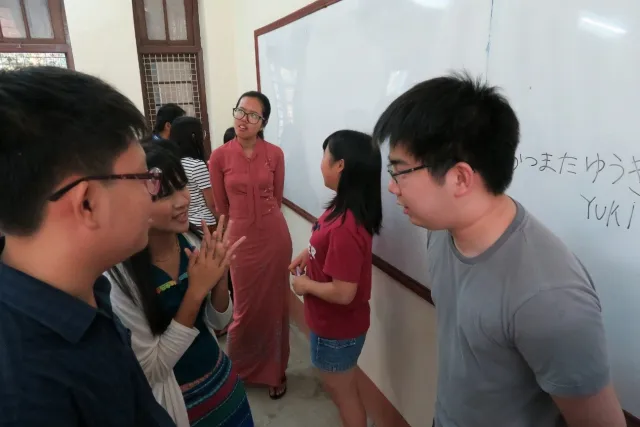
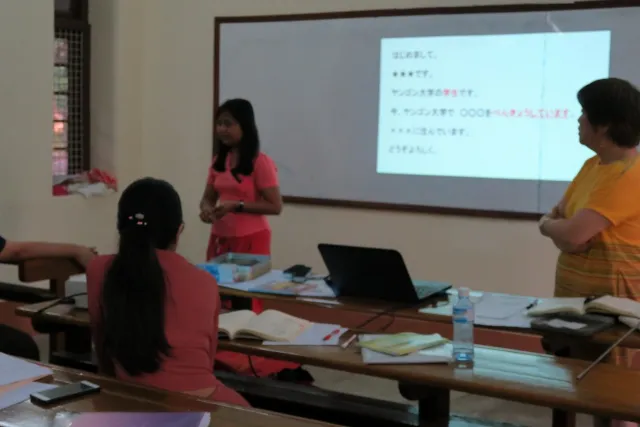
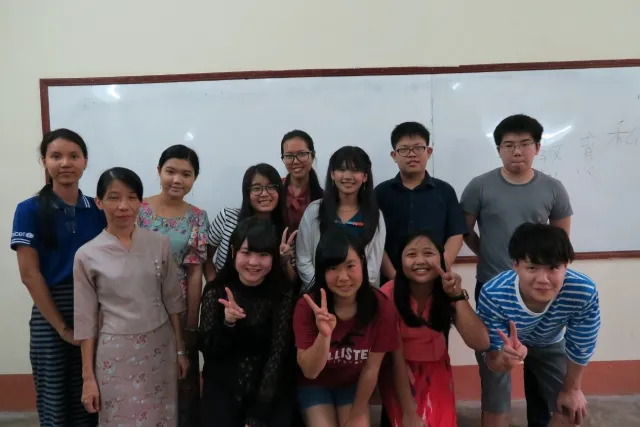
January Activity Report
5 February 2018
Global Japan Office Coordinator
Michiko Imai
I was very aware of the fact that Japanese learners from countries outside of the Sinosphere struggle with kanji, so for quite some time I had been thinking that it would be good to let my students experience calligraphy once so they are motivated to study kanji. Because of this, I put in a request for calligraphy equipment to the Japanese Embassy in Myanmar, to which they gave consent, and thus I was able to do a kakizome (first writing of the year) at the first lot of classes following the New Year.
Ideally, I should’ve taken time to teach them how to hold and carry a brush first, but the time we had in class was limited, so we had to dive straight into the kakizome.
I also didn’t have time to teach the students what kind of kanji are usually chosen for kakizome, and instead I told the students to think of a few words they like that are between one and three kanji long. The level 3 class chose relatively standard words, with ones like ‘daisuki’ (‘like very much’) and ‘okane’ (‘money’). I guess I can’t really say much if these are their favorite words…I’m not sure if they meant ‘money’ or ‘gold’ by ‘okane’, as Burmese people love gold, but perhaps that student really likes money. Either way, I didn’t have time to ask, but when I said that ‘you don’t really write that for kakizome’, they took it off their list. The level 5 class wrote words such as ‘kawaii’ (‘cute’) and ‘shukudai’ (‘homework’). Do they like homework? Even though they always make faces when I give them homework? Perhaps they secretly enjoy it. Hmm…
I cut down some of the students’ original ideas with comments such as ‘this isn’t good’, ‘this one is also weird’, and ‘we don’t usually write this for kakizome’, and made them write more standard kanji. I’m afraid I may have taken away their creativity. I should have let them choose words more freely. Next year, I will let students choose words the words they want to write freely, even if I think they are strange.
The students handled the brushes better than I expected, and enjoyed themselves thoroughly. They didn’t spill the ink everywhere as I worried they might, they cared for the borrowed brushes, and everything went well. I hope that because of this class, the students could improve the shape of their kanji and feel more motivated to study kanji.
Lastly, I would like to take a moment to say I am very grateful to the Japanese Embassy in Myanmar for lending us all the calligraphy equipment. Cèzù tinbadeh, thank you.
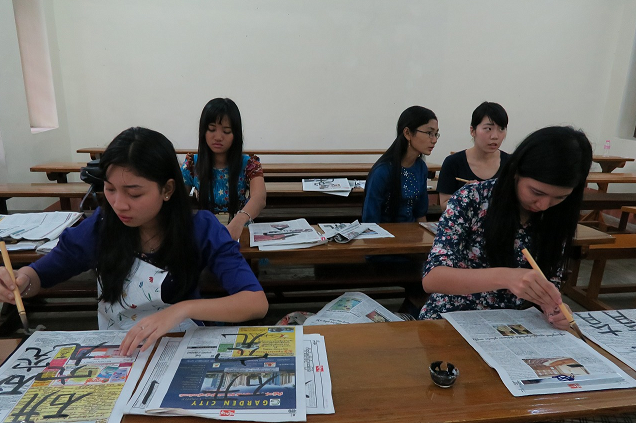
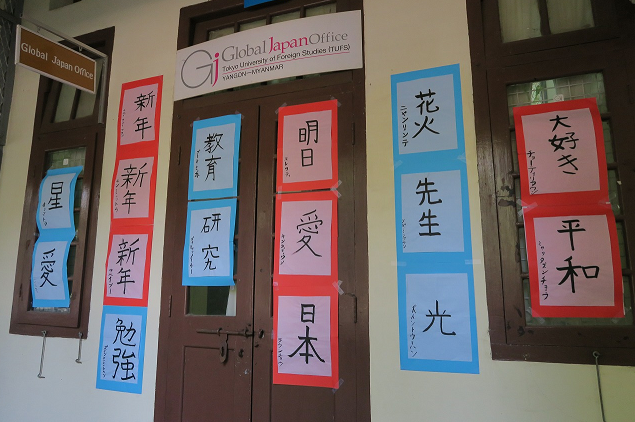
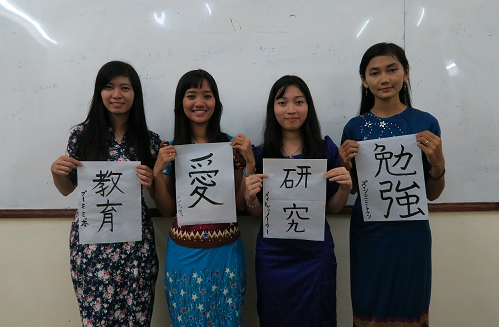
December Activity Report
5 January 2018
Global Japan Office Coordinator
Michiko Imai
I have been trying to introduce Japanese culture to the students at the University of Yangon little by little since last year, but in the end of 2017 graduate students at this university’s Japanese education department were brought here by the Japan Foundation and introduced to Japanese customs regarding the end of the year. The audience consisted of student who were in their third semester of studying Japanese, and they were Level 3 which meant that they only knew about a hundred kanji, so relatively easy vocabulary and lots of illustrations were used.
The presentation started by describing precisely what part of the year the term nenmatsu-nenshi refers to (namely, the period around the turn of the year), then went on to introduce concepts like New Year’s greeting cards, the twelve horary signs, toshi-otoko or toshi-onna (men or women whose age is a multiple of 12), end-of-the-year cleaning (similar to spring cleaning), the meaning of such decorations as Shimenawa, Kadomatsu, and Kagamimochi which are indispensable to the New Years, bell-ringing on New Year’s eve, and Hatsumoude. A lot of new things were introduced, but everyone seemed interested.
It would be ideal to be able to provide a description of Myanmar’s New Year’s customs in comparison to Japanese customs, and for students to be able to ask questions about what was not clear, or about what was interesting to them. But that seems to be a long way away. However I think they were able to get a slightly better understanding of Japanese culture and customs.
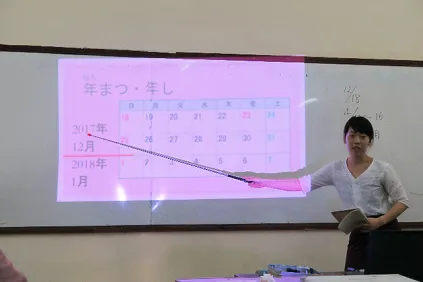
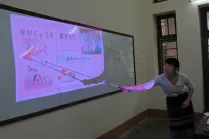
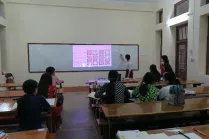
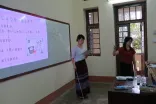
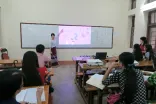
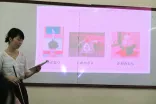
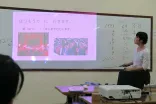
November Activity Report
5 December 2017
Global Japan Office Coordinator
Michiko Imai
In national universities in Myanmar, teachers and professors wear a short shirt called eingyi, and a traditional waistcloth-like article of clothing called a longyi. A graduate student in TUFS’ Japanese Education Department, who was sent here by the Japan Foundation as a Japanese education intern, brought black skinny jeans to wear at work. Wearing that made her look like a Chinese exchange student, and not at all like a teacher, so we decided that we would get her eingyi and longyi.
We met up with three students from the smartest class among the Japanese classes, and had them take her to the market near the university to pick out eingyi and longyi. The students helped the new teacher out using the Japanese they knew to determine the color, the price, and whether she wanted the strings to be tied or hooked.
Wearing the eingyi and longyi transformed her into a young, pale sayama (female teacher). Apparently this weekend the students plan to take the sayama to see the Shwedagon Pagoda, the most popular sightseeing attraction in Yangon. It was a good chance to practice using Japanese outside of class, and the graduate student was able to feel the warmth of the Burmese people. It was a promising start for students and teacher alike.
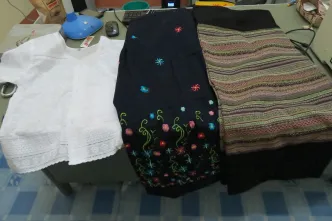
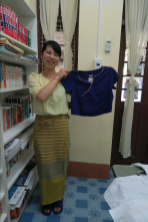
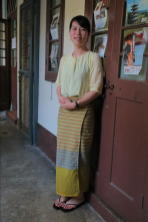
October Activity Report
3 November 2017
Global Japan Office Coordinator
Michiko Imai
There are three students from the University of Yangon currently on exchange at TUFS. One of these students is a literature department student who used to study Japanese at the Yangon GJO. Therefore, for this month’s correspondence I’d like to present some extracts from an interview with Thae Su Hlaing, the literature department student on exchange at TUFS.
This interview was conducted on the 2nd of November through Facebook Messenger’s voice recording function.
1. Tell us about a normal week for you.
――I have class nine times a week. Six of these are in Japanese, and three are in English.
2. What have you been doing in the weekends?
――I hang out with the Burmese teacher (a guest lecturer at TUFS) and my Burmese friends.
――I cook.
――I go to the library and read books.
3. What is it like living in Japan?
――The weather is very nice. I like it. I don’t feel homesick at all.
4. When you cook, where do you buy the vegetables and such?
――I go to Gyoumu Supermarket in Musashisakai. Because Gyoumu Supermarket is cheap.
5. What surprised you about coming to Japan?
――That Japanese people wear masks. On the plane from Yangon to Japan, about 4-5 people were wearing masks. When I arrived in Japan, about 20-30% of people were wearing masks. Why do Japanese people wear masks? Maybe they like them? I was surprised.
6. What do you think the weak points in your Japanese are?
――(In Myanmar) speaking.
(In Tokyo) everything is fine. I think the hardest is writing, both kanji and hiragana. I am writing a diary in Japanese.
7. What do you want to do in Japan?
――I want to go on a holiday.
(Where do you want to go?) First I want to go to Osaka. My second choice would be Tateyama Kurobe. I want to go everywhere.
(Why Tateyama Kurobe?) Because in the winter lots of snow falls, so I think it will be beautiful.
――I want to get a part-time job. Because there are no part-time jobs in Myanmar.
8. What is your Japanese goal before returning to Myanmar?
――I want to be able to pass N2 of the JLPT (Japanese Language Proficiency Test).
That is all.
I was surprised that, after listening to the recordings again, even though I spoke at a natural speed without making adjustments for her, she was able to listen and correctly answer my questions. Because she was able to reply so naturally, I didn’t even realize that I was speaking at a natural speed during the interview. Considering that has only been in Japan since the 26th of September, the fact that she can already speak so fluently is amazing.
I think this amazing feat is the result of four factors: being enthusiastic towards learning, being young and able to learn, being in an environment where you are showered in Japanese language, and being able to learn Japanese every day in a top class educational environment. I am so thankful for the teachers of the Japanese Learning Center at TUFS and their efforts every day. Thank you very much.
On top of that, she buys vegetables at Gyoumu Supermarket, almost like a housewife. She isn’t homesick at all, and seems to be enjoying her exchange, so I am relieved. I look forward to her return to Yangon next year.
September News from the Japanese Classroom
3 October 2017
Global Japan Office Coordinator
Michiko Imai
For three weeks from the end of August, first year students from the TUFS Burmese department came on a short term exchange program (short visit) to the University of Yangon. As part of that program, the students from Myanmar chose topics, discussed these topics, and held presentations on them as a part of tandem learning. When we announced that we would be doing tandem learning in the GJO Japanese class, over half of the students wanted to participate from the first day, making it a great success. However, for some reason, many of the groups chose ‘food’ as their topic…
During the group discussions, the first year TUFS exchange students and the students from Yangon had trouble communicating their ideas, but solved this thanks to the help of a TUFS exchange student studying in Yangon and three students that went on exchange to TUFS for one year. In the end the discussion became a multilingual discussion, with students switching between Japanese, English, and Burmese.
The group presentations were held in the third week, but due to the University of Yangon’s examination period being very close, the number of Burmese students attending dropped drastically. Despite this, the short term exchange students, and students that came in April, two ‘level four’ students (a zoology major and a Japanese literature major) and one ‘level two’ student (an English major), gave their presentations. The two ‘level four’ students worked hard and gave their presentation in Japanese. Apart from these students, there were no more presentations, but some Burmese students came to support the Japanese students from their groups, and watched their presentations, feeling both nervous and entertained.
From next year and beyond, I hope the students can use less English, and really dive into their discussions.
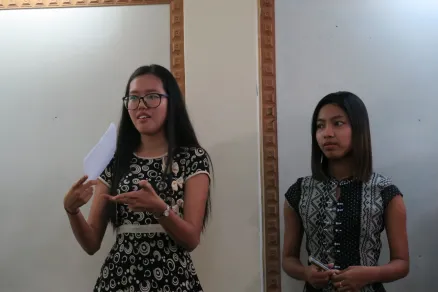
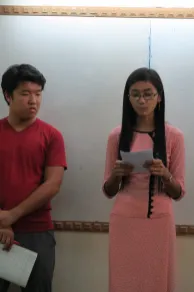

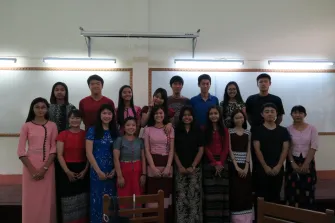
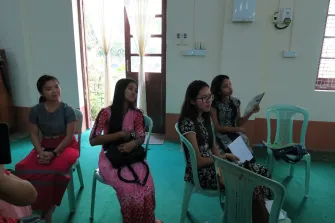
August News from the Japanese Classroom
9 September 2017
Global Japan Office Coordinator
Michiko Imai
The GJO Yangon Japanese class, started in June, came to a close at the end of August.
In the last class at the end of August, I had the level 3 students give simple presentations. In the 18th chapter of ‘Minna no Nihongo I,’ the students learnt the structure ‘my hobby is doing ~,’ so students added a few explanation sentences and talked about their hobbies. 12 students attended class that day. In this class, most students said their hobby was film or travel. One interesting hobby was ‘buying fruit at a department store.’ Everyone laughed after hearing this. Apart from film and travel, students also showed interest in reading, cooking, listening to music, drawing, and photography, and surprisingly no one mentioned sports. I guess it seems strange to get hot and sweaty from sports in an already hot Yangon. I often see young men playing Chinlone (soccer with a ball made of plaited rattan) in random places, and occasionally see people going on early morning walks on the University of Yangon campus, but I guess this class is not so interested in these kinds of activities.
As I only told students to use the structures learnt in class, and to explain them a little, I was worried how the presentations would turn out, but even with the few grammatical mistakes here and there, the students put all their sentences together nicely. I really want them to learn more vocabulary and grammar so they can talk a lot about themselves in Japanese.

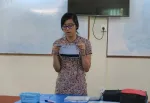

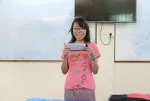

July News from the Japanese Classroom
4 August 2017
Global Japan Office Coordinator
Michiko Imai
This semester I thought of introducing Japanese culture and customs bit by bit to the students, I completely forgot it was Tanabata on the 7th of July. So on the day I quickly cut up some colored copy paper into tanzaku, and decided that I would have students write their wishes on them during class. I got some TUFS students currently on exchange here to explain Tanabata in Burmese, showed students some photographs of Tanabata, and got students to write their wishes on the tanzaku. I explained that when you write a wish, it must end in masu youni, and the students managed to write their wishes in both Japanese and Burmese. Some students even wrote multiple wishes on one tanzaku. There was a variety of different wishes, ranging from ‘I wish to become good at Japanese,’ to ‘I wish to become rich,’ to wishes concerning family and health, and even mysterious, secretive wishes such as ‘I wish for my wish to come true.’
I actually wanted some bamboo to hang the tanzaku on, but I didn’t know where to find it, so this year we hung them off the window grate along with some origami decorations we made. The students seemed to like the decorations, and commented on how they were ‘beautiful.’ I hope everyone’s wishes come true.
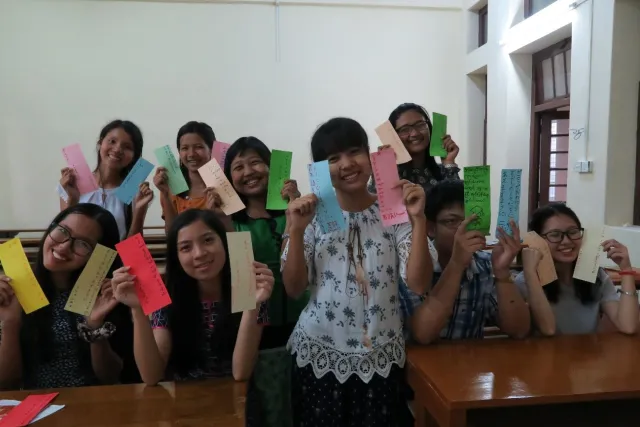
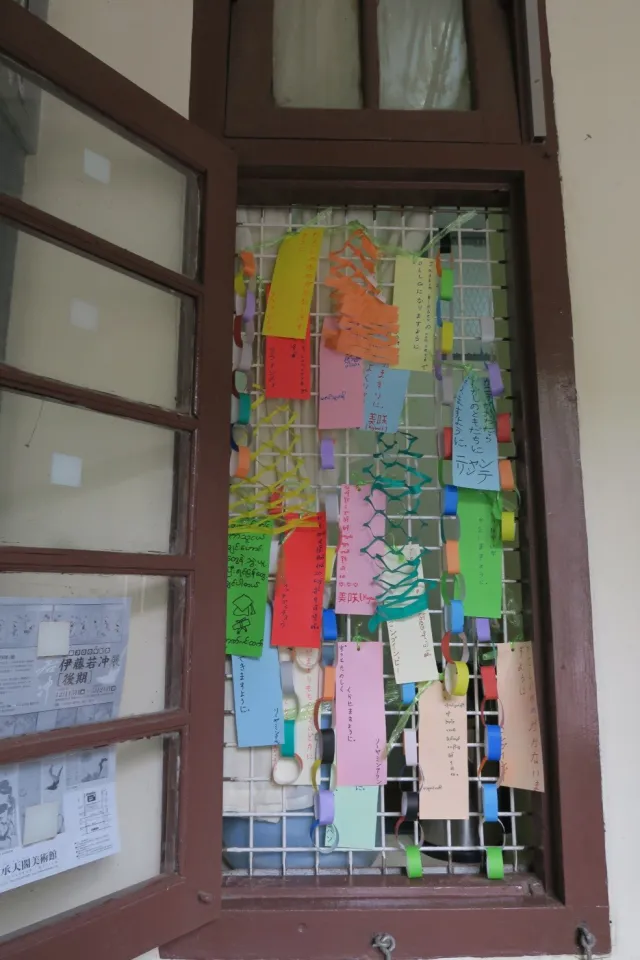
June News from the Japanese Classroom
5 July 2017
Global Japan Office Coordinator
Michiko Imai
On the 12th of June, in the height of Yangon’s rainy season, we were able to begin classes again for the second semester. In Myanmar, the first semester begins in December, and the second begins in June. I’m so used to starting classes in April, so it feels a little strange. This semester, students will advance from their Level 1 and Level 3 classes to Level 2 and Level 4 classes.
Last semester the GJO Yangon Japanese class had to move from classroom to classroom, as a sudden influx of exchange students left us unable to arrange a permanent classroom. However, this semester we managed to secure a classroom just two rooms away from the GJO Yangon office, which has made it much easier to carry equipment and teaching materials. Another good thing about this room is that you can enter with shoes on, so we no longer have to constantly take our shoes off and put them back on like before. The classroom we used last year didn’t allow shoes, so everyone had to remove them before entering. At first I was surprised and amused by this, because it was like entering a pagoda. However, unlike pagodas, there is a shortage of staff, so these classrooms aren’t cleaned very often, and the bottoms of my feet were always black by the end of class. Luckily I won’t have to worry about this anymore, so I can teach more comfortably this semester.
From my teaching experience last year, I realised that most of the students here don’t know much about Japanese culture (it’s actually surprising how little they know about Japan), so I decided that this semester I will introduce new vocabulary related to Japanese culture, and use pictures to help students understand. If the students can increase their knowledge of Japanese culture, then not only will their interest in studying Japanese increase, but it will also help them to understand more words in the textbook, and to make correct sentences in Japanese. For example, when learning how to ask about past experiences, practice questions in the textbook had students write their opinions on kabuki and sukiyaki. In this case illustrations were used to prompt adjectives the students could use. This exercise elicits answers like ‘it was beautiful. But it was hot’ for kabuki, and ‘it was delicious but sweet’ for sukiyaki, and is essentially a very easy exercise for students that know and understand the two words. However if the student does not know what kabuki is, they can’t really choose what adjectives to describe it with, and if they’ve never eaten sukiyaki, they will not know the taste, even if shown a picture. Despite not knowing the words, the students seem genuinely interested when I explain what they are.
Last month I introduced words that are considered symbols of Japan such as Mt. Fuji, ohanami (flower-viewing), Sumo Wrestling, kabuki (Japanese play genre), and tea ceremonies. I also taught the students words such as onigiri (rice balls), soba (buckwheat noodles), sukiyaki (a popular Japanese dish), autumn leaves, and Okinawa. The students were particularly astonished by a photo I prepared that had pink cherry blossoms on one side and yellow nanohana flowers on the opposite side, and let out many ‘ooh’s and ‘aah’s. Concepts like Sumo Wrestling and tea ceremony have long histories, so they take time to explain properly and unfortunately I can only explain them briefly, but I can see that the students are enjoying learning these new things, which makes me very happy. The last thing I always say is ‘you must try going to Japan,’ or ‘it’s so delicious, please you must try it when you go to Japan,’ so lately I sound more like a saleswoman than a teacher. But in all seriousness, I would love if even one of my students could go to Japan and experience our great culture, beautiful scenery, and delicious food. From explaining all about onigiri, soba, sukiyaki, and all the beautiful multicoloured tea cakes, I unfortunately felt a craving for Japanese food, followed by nostalgia and homesickness.
The Burmese language major exchange students from TUFS have been extremely helpful in these classes, as they can translate my explanations into Burmese, and help the students understand these new concepts. If it wasn’t for them, I probably wouldn’t have been able to teach these things effectively. I just want to use this moment to say how grateful I am to you girls. Thank you again, cèzù tinbadeh.
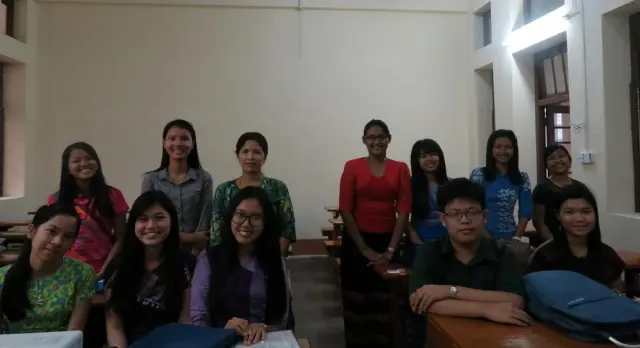
May News from the Japanese Classroom
5 June 2017
Global Japan Office Coordinator
Michiko Imai
The GJO Yangon Japanese language course is a contribution from TUFS, and is a part-time, non-credit course. The lessons are conducted after school, and students with enthusiasm take the trouble to come to the Burmese language faculty building once the lessons at each of their respective faculties have finished. Many of them are studying with the hope to study abroad in Japan or find employment in Japanese companies that operate overseas. This is because today in Myanmar, a high salary is guaranteed for those know Japanese. However, as an unfortunate thing that is common among all language subjects, the more advanced the lessons become the fewer students attend.
There are various reasons why they stop being able to come, but this year I think that we need to take various approaches to increase the number of students who continue with the course. As I look back on the various language classes that I’ve taken on and dropped out of, I think that the reason for stopping halfway was a lack of knowledge of the culture in the countries and areas where those languages are spoken. Simply learning increasingly difficult grammar week after week was uninteresting. I think that it could be more interesting if, while learning new vocabulary, we did things like looking at pictures and listening to stories related to those words.
The city of Yangon is full of Japanese-made cars, but among Myanmar’s people there are surprisingly many who have no knowledge of Japan. For the time being, in order to have the students know more about Japan, I am planning to introduce Japanese culture to the lessons little by little once they begin in the new term in June.
April News from the Japanese Classroom
4 May 2017
Global Japan Office Coordinator
Michiko Imai
At the University of Yangon, the end of term exams finished at the end of March, we entered the long holiday that extends through April and May. In Yangon, once April begins, the days over 35℃ follow consecutively and there is a long period of intense heat that feels around 42℃ -49℃, so there are hardly any students visiting the campus. They are in full holiday mode, either returned home or travelling with friends. To places where, during the two-month holiday, they will forget the Japanese they worked so hard to remember by the time the new term starts since they won’t have any contact with Japanese. In particular, kanji is easy to forget, and just as I was thinking I wanted to do something about it, at a Japanese language education seminar held at the University of Yangon on 4th April, the was a flyer about the Japan Foundation’s free learning app, so without delay I introduced it on the GJO Yangon Facebook page the next day.
By downloading this brilliant free app, ‘Memory Hint’, you can self-study kanji, hiragana and katakana with illustrations and voice audio, and you can also take quizzes. Just like young people in other countries, the students at the University of Yangon love smartphones, and they can use this app to study easily, so thinking that the students would surely be happy to receive it I enthusiastically made the post, but only 12 people ‘liked’ it. Perhaps they didn’t ‘like’ it, or they forgot to click on it, or they haven’t joined the GJO Yangon group… Even though everything seemed OK before we entered the holiday when I told them “I will be sending messages through GJO Yangon’s Facebook group, so be sure to check it often! Understood? OK?” “Yes!” “OK!”.
Amongst the Level 1 students there are some who write indecipherable hiragana and who don’t have a firm grasp on katakana, and there are Level 3 students who write alien kanji, so next term we need to strengthen their study of characters. In addition, it seems that tightening communication with the students and establishing methods of communication is a new problem.
